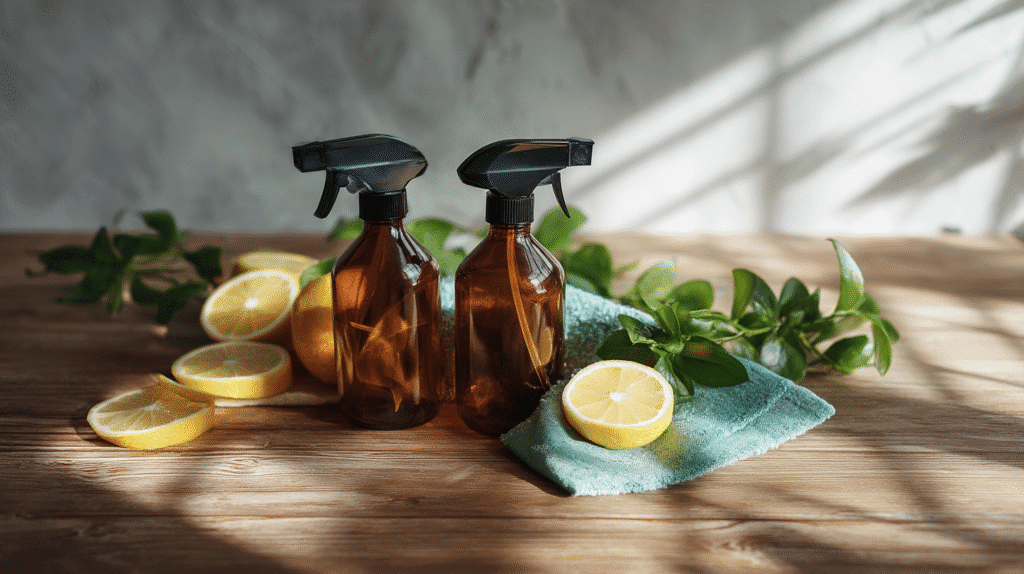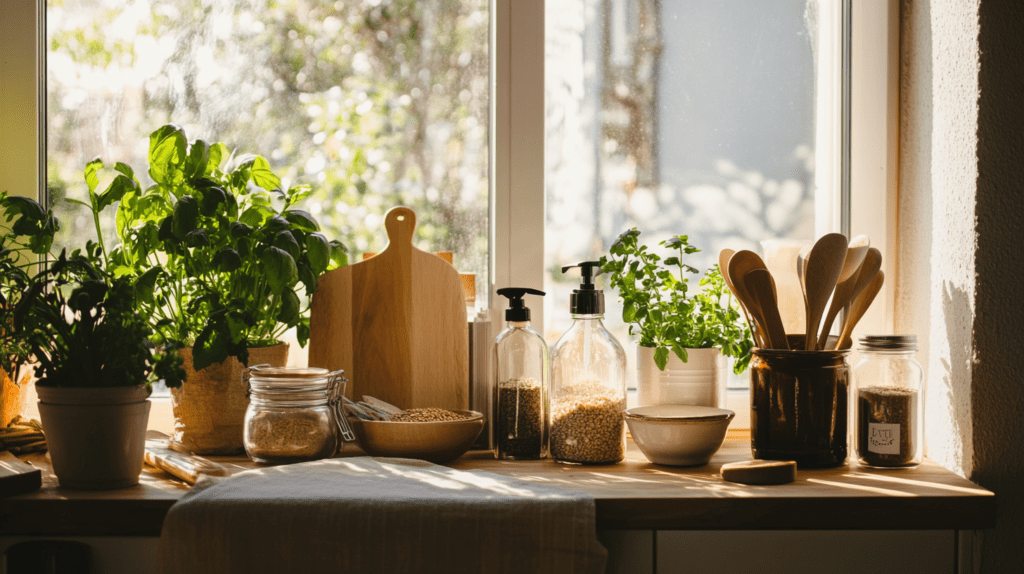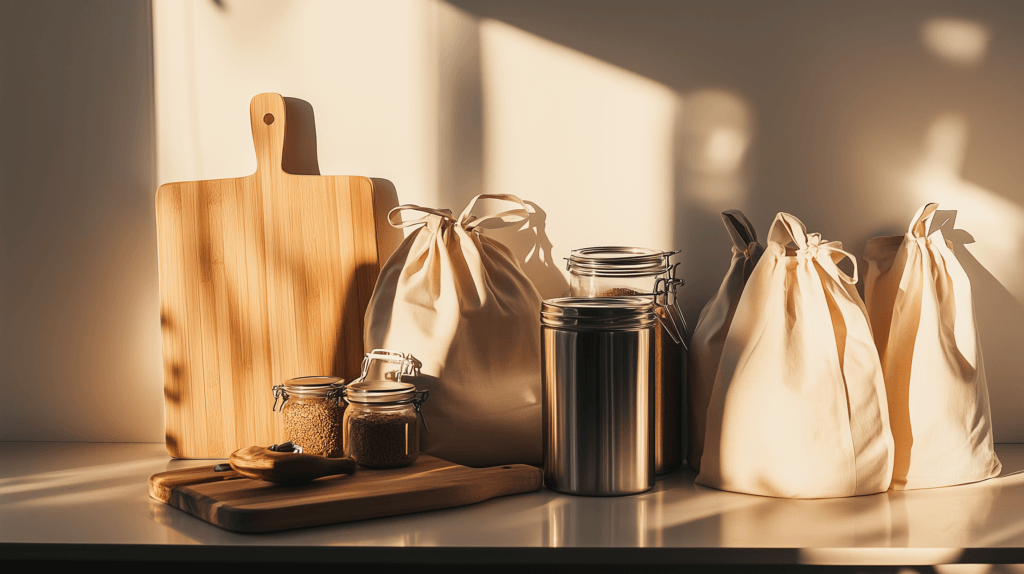This post may contain affiliate links, including those from Amazon Associates. If you make a purchase through these links, I may earn a commission at no additional cost to you. Learn more about our affiliate policy.
When I first started switching to DIY cleaning, I was skeptical to say the least.
How could baking soda and vinegar really do what my favorite store brands promised?
I’d grown accustomed to those powerful cleaners, convinced that strong chemical smells meant genuine cleanliness. But after experiencing headaches and mild asthma flares following a routine cleaning session, I had a wake-up call: it was time to explore natural alternatives seriously.
Maybe you’re feeling overwhelmed too. I get it, there’s so much noise out there about what “natural” really means.
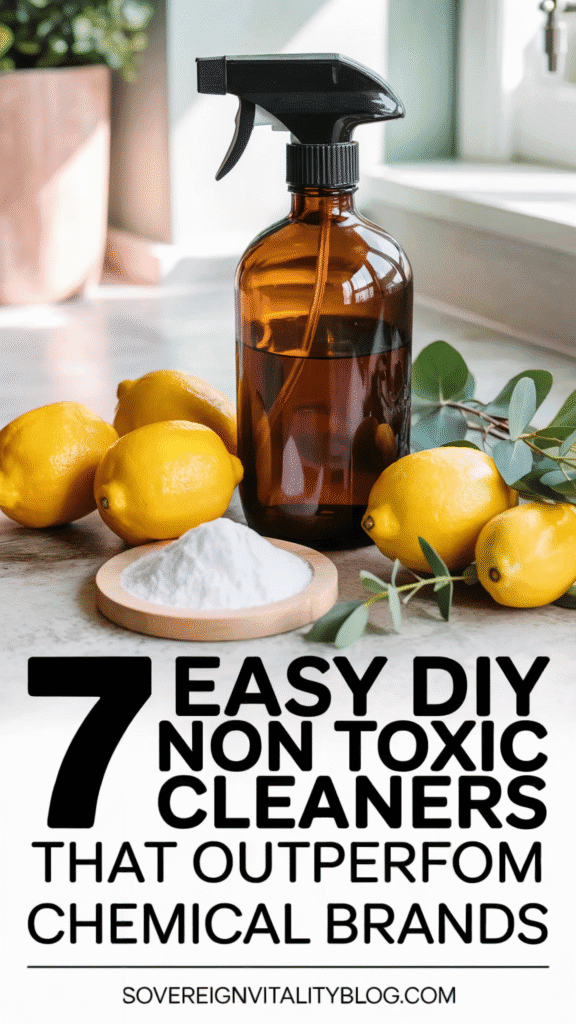
You might be wondering if homemade cleaning products are effective enough, or if they’ll require too much of your already limited time. Perhaps you’re wary of falling victim to yet another round of greenwashing from brands capitalizing on the wellness trend.
Let me reassure you: you don’t need harsh chemicals to get exceptional results.
In fact, creating non-toxic cleaning products DIY style has transformed my home but also detoxified my entire cleaning routine. Now, cleaning my home feels calming, sustainable, and even empowering. Here’s how you can effortlessly achieve the same.
Fragrance-Free Cleaning For Sensitive Households
Before we dive into the DIY recipes, I want to address something crucial for many households: fragrances. Synthetic fragrances are often considered the hallmark of a clean home, but that lemony fresh smell usually masks hidden chemicals.
These fragrances can contain phthalates, formaldehyde, and other hormone-disrupting substances. For sensitive individuals, these ingredients can trigger asthma, migraines, allergies, and skin irritations.
Best Unscented Commercial Products
If you prefer ready-made solutions or want to supplement your homemade products, choose genuinely fragrance-free products.
Some of my trusted fragrance-free brands include Seventh Generation’s Free & Clear line, ECOS Hypoallergenic Dish Soap, and Better Life Unscented All-Purpose Cleaner. Look specifically for products labeled “unscented” rather than “fragrance-free with essential oils,” as even natural scents can be problematic for extremely sensitive individuals.
How to Neutralize Smells Naturally
Avoiding synthetic fragrance doesn’t mean your home has to lack freshness. You can easily neutralize odors and freshen your living space naturally. Here are a few favorite techniques:
- Simmer Pot: Gently simmer citrus peels, cinnamon sticks, and cloves in water on your stovetop. This method naturally deodorizes your home, creating a cozy, inviting atmosphere without synthetic additives.
- DIY Air Freshener: Baking soda is brilliant for absorbing odors. Combine it with a few optional drops of essential oils like lavender or eucalyptus for subtle freshness. Keep this mixture in an open jar in any room needing a little pick-me-up.
- Open Windows & Plants: Simply opening windows regularly greatly improves indoor air quality. Adding air-purifying plants like peace lilies, spider plants, or snake plants enhances this natural purification process beautifully.
Here are 7 easy diy cleaners that actually work better than traditional chemical cleaners.
1. All-Purpose Spray
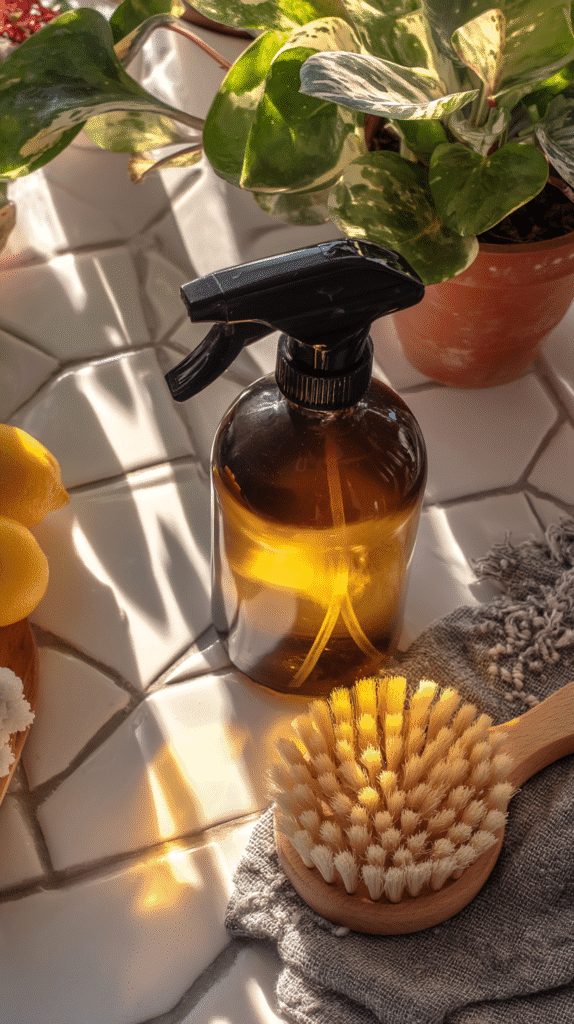
This homemade all-purpose cleaner quickly became my go-to for almost everything. It cleans beautifully, deodorizes naturally, and couldn’t be easier to make.
- Recipe: Mix equal parts white vinegar and distilled water in a reusable spray bottle. Add 10-15 drops of lemon essential oil. For tougher messes or greasy surfaces, I add a small dash of castile soap for extra cleaning power.
- Best uses: Countertops, sinks, cabinets, appliance fronts, tables.
- Note: Avoid vinegar-based cleaners on sensitive surfaces like granite or marble, as the acidity can cause etching.
2. Streak-Free Glass Cleaner
Store-bought glass cleaners often leave harsh fumes and residues. My DIY natural glass cleaner, on the other hand, consistently delivers a crystal-clear shine without chemicals.
- Recipe: Combine 1/4 cup alcohol (vodka or rubbing alcohol), 1/4 cup white vinegar, and 2 cups distilled water in a spray bottle. Optionally, add a single drop of citrus essential oil for extra freshness.
- Best uses: Mirrors, windows, glass stovetops, chrome fixtures.
- Tip: Wipe surfaces with a lint-free microfiber cloth for a streak-free finish.
3. Deep-Clean Grout Scrub
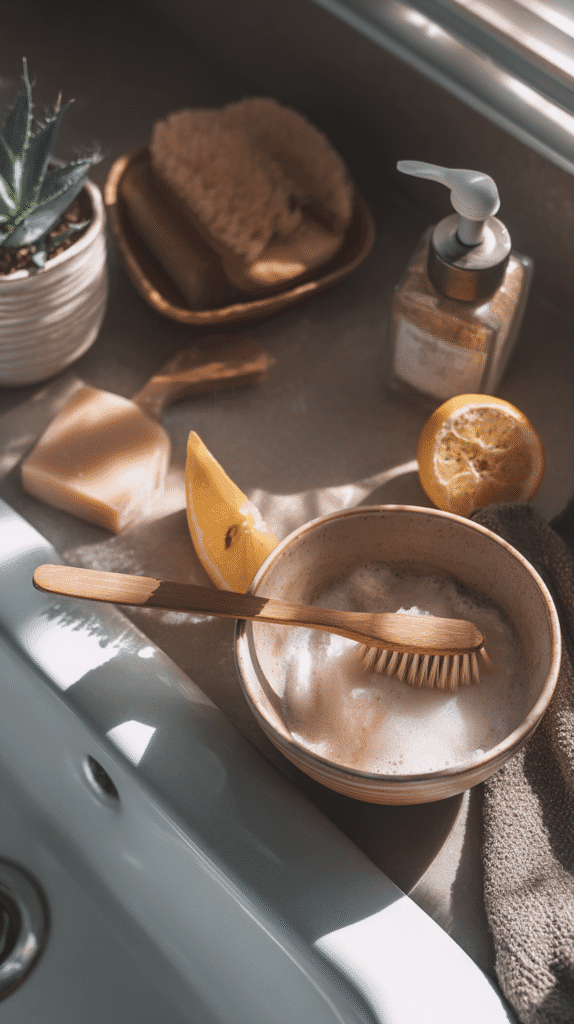
Tackling grout can feel daunting, especially without harsh cleaners. But this powerful yet safe combination works wonders on moldy or discolored grout lines.
- Recipe: Create a paste using equal parts baking soda and hydrogen peroxide. Spread the mixture onto grout lines using an old toothbrush.
- Directions: Let the paste sit for 10 minutes, scrub vigorously, then rinse thoroughly.
- Pro tip: For particularly stubborn stains, apply the paste and let it sit for up to 20 minutes before scrubbing.
4. Soft Scrub for Sinks and Tubs
This gentle but effective scrub is a staple in my cleaning toolkit, effortlessly lifting grime and soap scum from sinks and tubs.
- Recipe: Combine 1 cup baking soda, 1/4 cup castile soap, and 10 drops of lemon essential oil (optional) to create a creamy paste.
- Ideal surfaces: Porcelain, enamel, stainless steel sinks, tubs, and shower basins.
- Tip for tough stains: Sprinkle a little extra baking soda before applying the scrub for extra abrasiveness.
5. Natural Disinfecting Spray
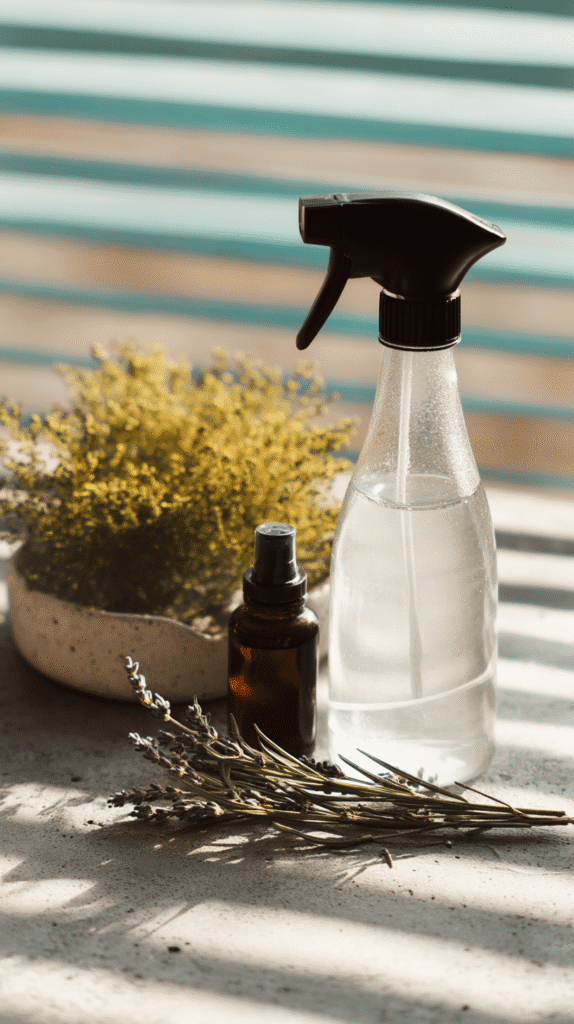
Having kids and pets at home makes disinfecting a priority, especially during cold and flu seasons. This DIY disinfectant is both effective and safe.
- Recipe: Mix 1/2 cup alcohol (70% isopropyl or higher) with 1/2 cup distilled water in a spray bottle. Add 15-20 drops of tea tree oil or lavender oil for additional antimicrobial power.
- Best uses: High-touch surfaces—doorknobs, light switches, electronics cases, and remote controls.
- Safety note: This formula is intended for surface disinfecting only and isn’t suitable for direct skin contact or food-preparation areas.
6. Mold and Mildew Spray (Bleach-Free)
Mold and mildew issues traditionally call for bleach, but there’s an effective natural alternative that’s safer for your respiratory system and the environment.
- Recipe: Mix white vinegar and tea tree oil in equal parts (undiluted vinegar is even stronger, but a 1:1 ratio works perfectly for regular use).
- Directions: Spray liberally onto moldy areas like tiles, grout, shower curtains, and window frames. Allow the solution to sit without rinsing immediately for maximum effect.
- Pro tip: Repeat weekly to keep mold and mildew growth at bay.
7. Gentle Floor Cleaner
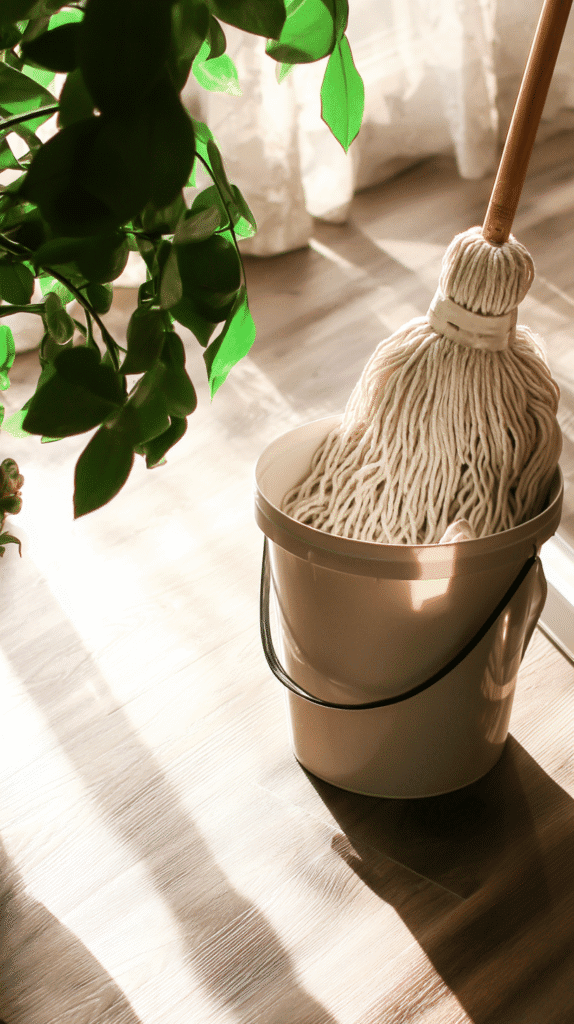
Floors bear the brunt of daily life, and commercial floor cleaners often leave sticky residues or harsh smells. This natural alternative effectively cleans without residues.
- Recipe: In a bucket, mix warm water with 1 cup vinegar and a few drops of castile soap. Optional: Add 5-10 drops of lemon or eucalyptus essential oil for natural freshness.
- Best uses: Safe for tile, vinyl, and sealed hardwood floors.
- Important tip: Always avoid excess water on hardwood floors—use a damp mop rather than a soaking wet one.
Conclusion: Clean Doesn’t Have to Mean Chemical
Shifting to homemade cleaning products was a revelation for me. It wasn’t just about eliminating the toxins, it was about reclaiming my home as a sanctuary free from the overpowering chemical smells and harmful residues.
I’ve discovered natural cleaning doesn’t compromise effectiveness or cleanliness. In fact, my home has never felt fresher or safer.
By taking control of your cleaning routine with these simple, affordable, and highly effective DIY natural cleaning recipes, you’re embracing a clean lifestyle on your terms.
Remember, cleaning your home shouldn’t cost your health or peace of mind, you’re not at the mercy of big brands anymore.

